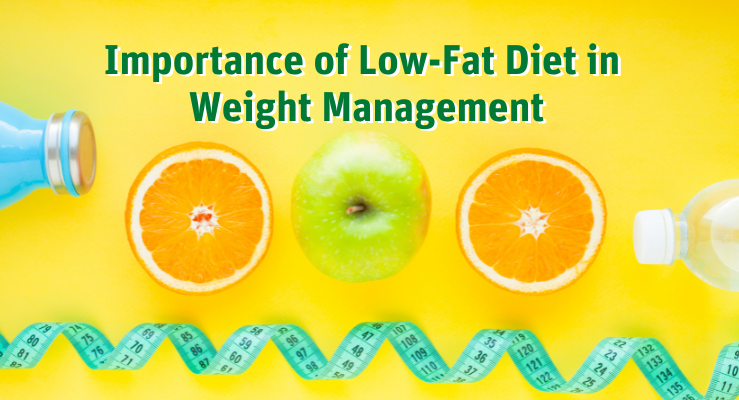
Importance of Low-Fat Diet and Exercise to Achieve Your Weight Loss Goals
Share
Being overweight puts you at risk of various health problems like type 2 diabetes, high blood pressure, health diseases, etc. To prevent these problems, it is important to maintain a healthy weight.
One of the most recommended solutions for reducing weight is to inculcate a low-fat diet in your routine.
What is a low-fat diet?
A low-fat diet is a dieting plan that is low in fat content. The dietary fats found in our food can be divided into two types:
1. Unhealthy Fats (or Bad Fats)
These are the fats that have negative health effects on your body especially when consumed in excess.
- Saturated Fats: Saturated fats are naturally found in animal-based food like processed meat, butter, cheese, whole milk, etc. These are also found in plant-based foods like coconut and cocoa.
According to medical professionals, not more than 7-10% of your daily calories should come from saturated fats.
Diets that are high in saturated fats can put you at risk of high cholesterol and heart disease.
- Trans Fats: These are often found in partially hydrogenated oil and occur naturally in fried and baked foods.
These fats increase your bad cholesterol and reduce your good cholesterol. They also increase the risk of developing cardiovascular diseases and type 2 diabetes.
Trans fats are often found in things like pastries, French fries pizza dough, etc.
2. Healthy Fats: Not all fats that you consume are bad for your health. Some fats leave a positive impact on your health. They are also known as good fats.
- Monounsaturated fats: This fat helps lower the bad cholesterol level of your body and plays an important role in maintaining overall health.
- Polyunsaturated fats: Like monounsaturated fats, this also helps lower bad cholesterol levels. This is also essential for several body functions like blood clotting and can be found in seeds, cooking oils, nuts, fish, etc.
These are considered good fats as they provide important nutrients and help lower the risk of heart disease and stroke.
Benefits of a low-fat diet
Fat provides a much higher quantity of calories per gram as compared to other nutrients like carbs and protein.
Fat gives around 9 calories per gram whereas carbs and protein provide around 4 calories per gram. Reducing the calorie intake by eating less fat can help you with your weight loss.
Weight loss: Reducing the fat intake through a low-fat diet can help lower the calorie consumption which in turn helps with the weight loss. It also lowers the cholesterol level and reduces the risk of obesity.
Heart Health: Lowering the consumption of trans and saturated fats that are often found in high-fat foods reduces the bad cholesterol level in your body which plays an important role in keeping your heart healthy and avoiding heart diseases.
Digestive health: Various high-fat foods are difficult to digest and can contribute to issues like indigestion, bloating, diarrhea, etc. By consuming a low-fat diet, you can avoid this and maintain a healthy digestive system. Low-fat foods consist of foods like cereals, grains, oatmeal, skimmed milk, beans, lentils, etc.
Role of low-fat exercise in weight loss
Regular exercise is an important component of weight loss, and it works best when paired with a low diet plan.
Combining exercise with a balanced diet is much more effective for weight loss than following a low-fat diet chart alone.
Increases metabolism: Metabolism is the process of converting food and drink into energy. Regular exercise increases energy consumption which in turn helps increase the rate at which our body turns food into energy.
Maintain and increase lean body mass: Lean body mass is associated with the number of calories you burn at rest. A higher lean body mass means that your body consumes more energy while doing nothing. This helps avoid calorie imbalance. Regular exercise helps you increase lean body mass and ultimately plays an important role in weight loss.
Choosing the Right Exercise: You need to find an exercise that suits you best and is something that you like the most. This helps ensure that you do it regularly and consistently, which is much more important than the intensity of the exercise.
Conclusion
A low-fat diet is an eating plan that comprises food with lower fat content. Lower fat content in food ensures a reduced calorie intake and plays a vital role in your weight loss journey.
It helps with weight loss, heart health as well as digestive health.
Fruits, vegetables, beans, and whole grains have vitamins, minerals, and dietary fibers that help reduce cardiovascular diseases and obesity.
However, following a low-fat diet plan alone is not solely responsible for helping with weight loss. It works best when it is paired with regular exercise also read how you can manage your appetite naturally with herbal ingredients for weight management. It is not necessary to be involved in rigorous exercises. It is much more important to perform exercises that you like as consistency matters more than the intensity.
